Key Takeaways
- A predicted upcoming shortage of technology leaders in higher education argues for support and development of diverse candidates to fill the leadership pipeline.
- Women tend to leave the IT career path in the middle levels, and fewer women are getting the education needed for IT staff and leadership positions.
- Women CIOs, who are still in the minority, have lessons to share about opportunities pursued and obstacles overcome that benefit all aspiring leaders.
- Institutions can take steps to develop (and retain) potential IT leaders, while individuals can develop professional skills and plan their careers.
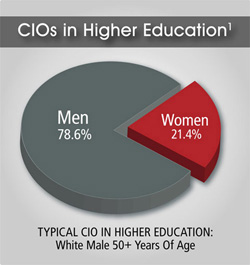
Figure 1
The growth and increasing criticality of the CIO role in higher education suggests the importance of recognizing and understanding the characteristics of successful CIOs and the environments supporting their success, with the goal of developing new leaders. Although the literature, in general, provides a rich knowledge base concerning IT leadership in higher education, most of those publications present information gathered primarily from male leaders1 (see Figure 1). Understanding women CIOs’ experiences in higher education is equally crucial for anyone aspiring to a technology leadership position on campus. That knowledge can also guide institutions in developing and retaining potential IT leaders from a wider, more diverse pool of candidates than in the past.
This article covers both individual and institutional approaches to IT leadership. Personal experiences and situational factors presented here suggest opportunities for those pursuing higher education IT leadership roles. Because of historical and current institutional practices and beliefs about the ideal characteristics of leaders, women especially need to build excellent leadership skills as well as recognize and take advantage of experiences leading to leadership opportunities. Institutions, for their part, need to provide such experiences and recognize and support individuals who aspire to IT leadership positions. (For sources see the sidebar “Women and Leadership.”)
Three current trends might leave organizations scrambling to find qualified IT staff and leaders in the near future, making it particularly important to develop and retain aspiring women technology leaders:
- A large number of retirements in higher education at the CIO level will occur within the next five to ten years.
- A decreasing number of college students are graduating in computer science and several other technical fields in which IT staff typically are educated.
- The number of IT jobs in the workforce is predicted to continue to increase substantially.
Accompanying these trends is the fact that the number of women receiving degrees in computer science and technical fields and the number of women in the IT workforce are declining dramatically. (For sources on these trends, see the sidebar “Trends in IT Employment.”)
How are higher education IT organizations responding to these trends? While some literature addresses strategies related to encouraging and supporting young girls’ and boys’ interests in technology,2 a research gap still exists in identifying experiences and factors leading to opportunities for women pursuing CIO positions on campus. Fostering a qualified pool of potential leaders for higher education requires attending to this research gap.
My work not only investigates and identifies opportunities for women CIOs in higher education but also the obstacles encountered and methods used to overcome them and to facilitate opportunities as women CIOs pursued their positions. I have also investigated institutional gendered norms and occupational jurisdiction — the legitimacy, power, and access to certain technologies due to one’s position — within higher education IT organizations.3 This article discusses the many lessons learned from the information provided by women CIOs in higher education regarding the opportunities that assisted them in building leadership skills and attaining IT leadership positions.
Lessons from “The Pioneers”
Three female senior executive IT leaders (whose titles I have grouped under the term “CIO”) from Master’s Medium and Master’s Large public institutions (see the Carnegie Classification System) in the United States participated in the qualitative study discussed in this article. Using the pseudonyms Alice, Grace, and Helen, this article presents the perspectives of three participants about their journeys to becoming IT executive leaders in higher education. The women were assured anonymity so that they could speak frankly about a variety of personal experiences. Over a period of eight months, I conducted two in-depth face-to-face interviews and one follow-up phone interview with each of the three women CIOs. Several patterns and themes became evident from these conversations.
You are missing some Flash content that should appear here! Perhaps your browser cannot display it, or maybe it did not initialize correctly.
Grace: My experience as an IT leader — regarding being a female — I think that I am a pioneer in the area. And of course being a pioneer, there’s lots of obstacles that you have to overcome. And you know one of them is being a female in a male traditional role as an IT leader. I would say, you know, overall it’s been a positive experience — I think because of some of the ways that I chose to handle certain situations. It could have been a negative situation — you know, my judgment or my mentality could have very well been clouded with negativism. But I tend to take things in the positive stride and just continue to work on the positive end of it.
Several experiences, which they described, led to opportunities for the three women CIOs. Also, certain elements present in their lives created opportunities for them during their career development and professional advancement. These “lessons learned” can assist both women and men pursuing higher education CIO or other leadership roles and provide guidance to institutions and organizations looking for ways to attract and retain IT staff and leaders.
Creating IT Leadership Opportunities
Building excellent personal strengths, seeking out and obtaining guidance from mentors, having family support, possessing good knowledge and varied relevant experiences, and building contacts through networking and involvement in professional organizations can all lead to opportunities for achieving or being recruited into higher education IT leadership positions. Communication skills, taking initiative, and leadership skills and styles were personal strengths emphasized by the women participants as important and helpful.
Communication Skills
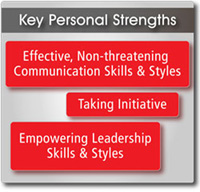
Alice, Grace, and Helen all stressed the importance of excellent communication skills for themselves and their staffs. They described communication skills as “critical” for providing opportunities to access IT leadership roles. They also discussed the importance of communication taking place in a “nonthreatening, respectful” manner. In addition, higher education IT leaders need effective listening skills. The women explained the importance of staff having someone to talk to and that as leaders they needed to be “good at listening and hearing multiple sides of any kind of conflict” and consistent — “steady, level, not up, not down” — when listening and communicating.
Grace emphasized that an integral, central aspect of listening for those in leadership positions is to “… listen to what’s not going on … what’s not being said.” She remarked, “The verbal and the nonverbal [are] very, very important.” Nonverbal aspects of communication, such as gestures, facial expressions, and eye contact, can often communicate just as much or more than the verbal content.
Excellent communication encompasses a wide range of skills and is important for current and aspiring higher education IT leaders because it provides the basis for interaction not only with IT staff but also with the entire campus community. Having good communication skills contributes to the CIO’s ability to strategically link the efforts and visions of the higher education institution and IT organization into a unified campus plan that can be successfully implemented.4
Taking Initiative
Opportunities can also present themselves as a person takes initiative and becomes involved with a variety of projects. To some, this might seem like an obvious element of working in the IT field because change is a constant. Alice described her response to opportunities allowing her to become involved with projects: “You know what, I’ll volunteer for that. I’ll do this. I’ll do whatever it takes.” Helen discussed the need to juggle many projects at once, leading to the need to be “well organized.” For the women and for others hoping to pursue CIO or other leadership roles, taking initiative can assist with developing independence, earning recognition, and being rewarded.
Leadership Skills and Styles
Another important personal strength is a person’s leadership skills and style. A large amount of research reported in the management literature indicates men and women leaders and managers possess comparable values, motivations, traits, and leadership skills. Yet women are often perceived as different and thought to be less likely to succeed in leadership roles.5
Higher education IT organizations need to retain and support strong leaders already in place while also seeking out promising individuals and encouraging those in the leadership pipeline. These current and future leaders are critical for the operation of forward-looking and forward-performing institutions. The literature yields a variety of publications detailing effective leadership skills coupled with leadership styles.6 Recent findings point to organizations moving away from autocratic or top-down management styles in favor of participative styles that are more supportive and interpersonal. Transformational, interactive styles represent an important approach to leadership as organizations become more diverse, team-based, and networked throughout the global economy.
You are missing some Flash content that should appear here! Perhaps your browser cannot display it, or maybe it did not initialize correctly.
Marilyn: Grace, tell us about your leadership style.
Grace: I think that I’m more of a mentorer or coach. I think I’m more participative.… I tell everybody I’m really here to remove obstacles and provide you with the tools so that you can go and do what you need to do and provide some direction. A strategic direction. And if you need me to do mentoring or I see that you need help, then you know it is part of my job to help you with that — as well as guidance or thought-provoking discussions.
But I am also a results-oriented person. My approach is just different from most results-oriented persons. I don’t beat people over the head for their work. But I do follow-up on their progress, and I think that’s part of management.
I make sure I deliver what I say I’m going to deliver, build that credibility, that rapport. I connect with people — because I do care about people. I do care about what I say, how I treat people, about their well-being.
Marilyn: Alice?
Alice: I feel that leadership is very important, and the leadership qualities of someone who can be confident yet can communicate, can listen, can accept ideas, can admit when they’re wrong, or can say, “Okay, you know what? Let’s try that, ’cause this isn’t working.” I’ve never been afraid to step back and say that. I’m not one that it has to be my idea. I like to give credit to others when it’s due. I don’t like to be in the limelight — that’s not where I want to be. I want to be a support, you know. So I think that helps a lot. I’m not a person who feels they can know everything. I can’t be an expert in everything, and that’s why I have people that work for me who are.
Marilyn: Helen, how do you describe your leadership style?
Helen: One of my best strengths is that I’m extremely well organized, and that has always helped me in administration. I think I’m pretty good at listening and hearing multiple sides of any kind of conflict. I think I’m a pretty good mediator, bringing people together to work out things.
I try not to micromanage, although I’m willing to step in and get involved if I see that things aren’t going well. But when you’re in IT, you’re hiring skilled professional people who are very good at what they do, and they need to be given that free rein to do what they do best. I couldn’t possibly learn every aspect of everything that they all do. And I think I get a lot of joy out of seeing my staff be successful. And I am happy — I’m just as happy if not happier — to brag about their accomplishments as I am to brag about my own. I know that there are leaders out there who don’t think that way. They are leaders who want all the glory to come to them. And I am not one of those.
I would also say that as I’ve gotten older, I’m more decisive than I was when I was younger. I have kind of a wealth of experiences to look back on, and the fact that I’ve tried to make my decisions be principle-based means that I can more quickly match the current situation to past examples — to the principles that I use to make decisions.
While the women described themselves as having a caring, interactive, participative, and empowering style, each also reported situations when they took decisive actions. As Eagly and Carli noted in writing about women becoming leaders, women leaders must be careful to avoid being characterized as maternalistic.7 Senior levels of management often view a helpful style in women as maternalistic and consider it less essential; such a leadership style can even be detrimental to women’s promotions or attainment of top positions.
Individuals seeking IT leadership positions must be ready for opportunities that present themselves by having effective decision-making skills and building strategic alliances.8 They should also consider a “collaborative union”9 of traditional male/female skills and styles. Individuals should pay careful attention to the use of effective styles, whether democratic, autocratic, or in-between,10 that best fit the situation and best benefit organizational functioning.
Mentors
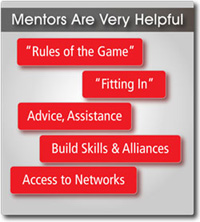
Mentors often facilitate professional advancement. They are particularly helpful in creating opportunities for those seeking roles in higher education administration because higher education has so many strong networks. Mentoring relationships assist with understanding the “rules of the game,” providing positive support and feedback, providing guidance on “fitting in” to the institutional or organizational environment, and providing invaluable contacts for those seeking leadership roles in higher education.11
Many who have reached the upper levels of leadership acknowledge the importance of effective mentoring relationships in providing advice and guidance along the way. Alice, Grace, and Helen highly valued the mentoring relationships each had during her career development. Their mentors “showed them the ropes” and were “really important” to them in offering assistance. Helen’s mentors “recognized [her] abilities early on” and “helped [her] do her best.” She stated that without her mentors, “it would have been much harder” for her. Alice described her mentors helping her grow and learn “at different stages of my life…. (T)hey each helped me at different times … [with] learning how to deal with people, with situations…. Learning more about politics…. [and] how to realize that you need to pick your battles.” Grace described one of her mentors as “…[taking] me under his wingtip … and was incredibly helpful.” Mentors assisted the women CIOs with building self-confidence, “broaden[ing] horizons,” and getting them “on the right path” as they pursued their careers and became CIOs.
Mentoring relationships and programs can provide men and women seeking IT leadership positions in higher education with an effective way to build strong skills and alliances. Mentoring relationships are particularly important for women because they generally lead to more promotions, increased power, access to internal and external networks, recognition, satisfaction, job mobility, and greater access to decision-makers than women would otherwise have. Many doors are opened and opportunities realized when individuals can establish effective mentoring relationships.
Family Support

Support from family members, particularly parents and spouses, can allow those seeking or in leadership roles to take advantage of opportunities otherwise not possible. This is particularly important for women — childcare, eldercare, financial, and household responsibilities can often present themselves as obstacles to a woman’s career. It is still generally accepted that women bear the brunt of family responsibilities and often lack the personal support system that men frequently have.12 The three women interviewed stressed the importance of support from their spouses at some point in their professional journeys. Two of the women had no children, which eliminated those family responsibilities. All stressed the importance of support and words of encouragement from their fathers as well, who were described as “important role models” encouraging them to “do whatever you want to do” and “be whatever you want to be.”
Alice, Grace, and Helen noted the changing role of many men today in providing career support for their wives by taking more responsibility for childcare and home tasks. Higher education IT leaders and those seeking such positions, particularly women, need to be open in discussing with their families the support needed to enable their success and their ability to seize opportunities. It is important for both women and men to acknowledge and appreciate family support in order to build strong family relationships while pursuing their career goals.
Education, Knowledge, and Experience
Various combinations of education, knowledge, and experience certainly influence an individual’s professional advancement opportunities. Many who work in higher education IT organizations have backgrounds in business, computer science, information science, engineering, or engineering technologies. Listen to the women’s words (in other’s voices) as they discuss elements related to education, knowledge, and experience that provided opportunities for them.
You are missing some Flash content that should appear here! Perhaps your browser cannot display it, or maybe it did not initialize correctly.
Marilyn: Helen, tell us how your educational background, knowledge, and experiences provided opportunities to you as you pursued the IT executive leadership position.
Helen: I think that the fact that I came out of the faculty was a huge plus for me — for getting into higher ed administration. And by moving into information technology I think it was much more easy to do in higher ed than say, “I’m going to go out and get a job in industry being the head of IT.” I had a degree in computer science, a position on the faculty in computer science — that helped — because I think I understand what it’s like to be a faculty member and I think to be successful in IT you have to have a good understanding of your customers. Your students come and go, but the faculty are here for a long, long time. But I also know there are lots of IT leaders in higher ed out there that don’t have that faculty background and do just fine.
Marilyn: Alice discussed acquiring more education in order to pursue the CIO position.
Alice: My prior boss didn’t feel that I probably would be given the opportunity for the position without more education. And in talking with my faculty advisor and mentor, he thought — and this was odd coming from a faculty member — he goes, “For what you do, you don’t need that. You’re experience needs to come from being in the trenches and doing your job.”
And I think the confidence that a person has — or a woman has — also helps.
Marilyn: Grace?
Grace: Well, I think that education gave me more opportunity to get in the door, so that I could actually market myself better. I think it certainly helps to have a background, a strong background, in technology for this particular role … because it not only helps you with understanding the internal workings of how technology and IT organizations should work and each person’s job function … it helps you connect with your staff. However, I don’t believe that in this position that you necessarily have to have a technology background. I think it helps me to look at things from different perspectives. I think one of the biggest things that it has helped me to do in my career path is to work with cross-functional departments, look at cross-functional needs, look at the big picture, as well as being able to adjust and look at things from a specific standpoint…. And I think that has helped me not only in my career path but in my entire life, outside of work as well, to be better at analyzing situations — to come up with the best possible solution and also to help me work with people and compromise.
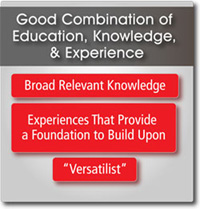
A good educational background, wide-ranging knowledge, and a variety of meaningful experiences provide many opportunities for those pursuing IT leadership roles. Higher education CIOs need much broader knowledge than can be gained from simply working in the IT field. As Grace pointed out, “this is a more strategic-level position.” When reviewing the literature regarding knowledge and experience needed by higher education CIOs today, often listed is knowledge of:
- Strategic planning
- Marketing
- Budgeting
- IT issues, trends, and challenges
- Business processes and university operations
- Institution-specific culture
- Local, state, and national higher education environments
For more on these concepts, see the sidebar “Knowledge and Experience Needed by Higher Education CIOs.”
Zastrocky13 discusses the higher education CIO as needing the education, knowledge, and experience to be a consultant and visionary. He describes today’s CIO as needing to be a “versatilist,” meaning someone who has a depth of skills and experience coupled with education and knowledge, can understand the scope of roles and assignments they must fulfill, and can deal with a variety of people and change. Acquiring these abilities and proficiencies can provide many opportunities to those seeking higher education IT leadership roles.
Networking and Involvement in Professional Organizations
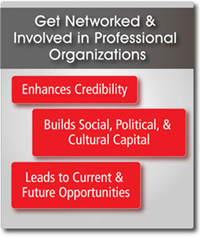
Networking with others provides formal and informal contacts that can open doors for those pursuing IT leadership roles in higher education. Individuals can often build credibility through involvement in professional organizations. Networking and professional involvements assist in building social, political, and cultural capital — especially for women.
Helen attributed some of her early involvement in professional organizations to a male mentor opening doors for her, enabling her to “contribute to the profession” and build credibility. She said, “I started volunteering for committee work and getting chosen, partly because I think he [her mentor] knew me and picked me a couple of times….” Grace said that informal networks “… very much helped for mentoring and coaching and guidance.”
Traditionally, men have been more involved and accepted in IT formal and informal networks and professional organizations than women. In addition to organizations such as EDUCAUSE, many women IT leaders attend conferences and participate in organizations focused on women in IT or women in leadership roles because these groups allow for additional networking and focus on reinforcing one’s confidence and self-esteem. Such organizations can help women combat isolationism and the disconnectedness that can result from juggling home and work responsibilities. Women in Technology International (WITI), the American Association of University Women (AAUW), the Office of Women in Higher Education (OWHE) under the American Council on Education, and state-based women in higher education or IT leadership groups are a few such organizations in existence today.
Personalized Recruitment

Recruitment can occur in many ways for those aspiring to leadership positions. Individuals may be recruited from within the organization, from outside the organization as someone unknown, and from outside the organization as someone known to the organization.
You are missing some Flash content that should appear here! Perhaps your browser cannot display it, or maybe it did not initialize correctly.
Alice: I actually turned them down twice. And they kept coming back. On the third time I said, you know, something’s going on here. I’m going to take a drop in pay, but I think that this is the right move because I think there will be different opportunities, because I’m not getting anywhere here. And so I decided to take the position. It turned out awesome!
Grace experienced recruitment in past positions and described a recent recruitment experience after starting her current CIO position: “(A)fter I got this job, you would not believe how many people have called asking me to apply for other VP jobs in their institutions.” Perhaps higher education is taking greater pains to recruit women into IT leadership position; Grace did not offer a theory on the motives behind those efforts.
Organizational Support
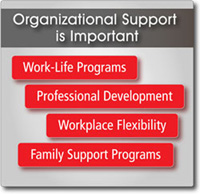
Many studies have found that organizations offering and supporting work-life practices and programs such as job sharing, flexible work schedules, telecommuting, childcare, and flexible leaves are able to recruit and retain employees, especially women and younger candidates, in greater numbers. They also experience less absenteeism, less job turnover, greater job satisfaction and commitment, and increased productivity from staff involved in such programs.14 The three women CIOs interviewed found support programs offered by their organizations to be very beneficial in providing opportunities for professional growth and development.
Helen described “tak[ing] advantage … of a number of programs for aspiring administrators,” while Grace described opportunities she had to flex her schedule as a mother and found “that was more important than the pay.” Family support programs and initiatives involving childcare and flexible work schedules benefited not only the participants but also their staffs. Yet Helen struggled with family support programs, describing them as “hard on the work organization.” She discussed the importance of an IT organization in higher education serving its clients: “I want people here to serve customers.” Alice stressed the importance of finding a “good balance” in such situations. Not only women, but men as well, find value in organizational support programs as they attempt to simultaneously share family responsibilities and take advantage of professional development opportunities.
Work and life responsibilities need not be mutually exclusive. Organizations and the men and women involved need to understand that responsibilities, duties, and opportunities in one area impact the other. As Grace explained, “People come into the work environment as a person. That means that whatever was going on at home or in their personal life … comes with them.” Institutions and organizations must recognize their responsibility in providing a family-friendly, supportive culture, which is often essential in attracting and retaining employees. Supportive programs can help the organization keep qualified staff who can grow their skills and develop professionally even during times of shifting family responsibilities or other personal need.
Creating Opportunities for Future IT Leaders

At a time of looming crisis in gender diversity in IT fields,15 at a time when 56 percent of women at the mid-level point of technical careers drop out,16 and at a time when the U.S. Labor Department is predicting that more than a million IT jobs will be added to the workforce by 2014,17 institutions and organizations must realize that women and minorities are valuable resources who deserve the opportunity to participate in innovating and advancing technologies on our campuses.
You are missing some Flash content that should appear here! Perhaps your browser cannot display it, or maybe it did not initialize correctly.
Marilyn: Alice discussed the equity issues of affirmative action as equally important to one’s competence.
Alice: You can be given opportunities, but you still have to follow through. It’s not like, you know, you can just say, “Okay, I’ll take that” and never do anything to prove yourself.
Marilyn: Helen expressed concern about the lessening attention to affirmative action during recent years.
Helen: In the early days of overcoming some past discrimination, affirmative action was a stronger force and more effective. And as there become more women in the workplace, and I’ll say that for minorities as well, I think that as more opportunities become available for the disenfranchised that there is sort of a public perception that there is less of a need for that. And even to the point where there starts to be some backlash. Even people who might have benefited by affirmative action start to turn their backs on it. There was a time when I first became an administrator [that] about half of the top administrators at my institution were women. And then now, in the Dean’s Council there are only two of us. So there’s kind of been a shift back. I think they’ve come to take diversity a little bit for granted. I think they’re trying less hard. You know, I think that maybe there’s a sense that “been there, done that, we’re through that now and we don’t have to think about it as much.”
Marilyn: Grace?
Grace: I don’t think that I would be where I am today, or even in some of the other positions that I’ve had, if it wasn’t for affirmative action and, you know, Title VII and all those types of laws. I also think that at some point along the way, different organizations realized that they are better off having a diverse of pool of people than just a single race or gender.
While it has recently become more accepted for women and minorities to hold leadership positions in higher education IT organizations, white men continue to dominate those roles. Strong institutional leadership is needed to add diversity to IT organizations, especially at the leadership level.
Institutional Recommendations
The following recommendations for institutions to pursue in developing and retaining IT leaders, especially women, are based on the information gathered from the women CIOs interviewed:
- Establish and celebrate mentoring programs, working closely with those involved to ensure success.
- Create and enhance professional development opportunities allowing staff, especially women, to gain vital leadership skills.
- Encourage staff, especially women, to acquire the necessary knowledge and skills for technical positions.
- Establish staff development grants and reduced tuition programs that assist staff in obtaining relevant education.
- Publicly recognize those who lead successful projects, initiatives, and functional groups in IT so that others can learn from them and so that they can serve as mentors and role models.
- Encourage and promote networking opportunities within as well as outside the organization and encourage individuals’ involvement.
- Promote diverse work groups and progressive organizational change that accepts and creates fairness for women and minorities, keeping affirmative action in the forefront.
- Educate people about the benefits of diversity within work groups before and during the process of work-group integration, supporting these efforts with mentorships of individuals.
- Review and revitalize different support and work-life programs that assist those facing different life situations and needs, allowing them to meet the demands of today’s work environment and allowing the organization to continue to benefit from their expertise.
Recommendations for Individuals
Historical and structural constraints often restrict certain career pathways to certain individuals. When opportunities arise and present themselves, individuals need to be ready to seize the chance and commit to success. The following recommendations for individuals seeking IT leadership positions, especially women, are based on the information gathered from the women CIOs interviewed:
- Acquire a wide-range of personal skills and strengths, including excellent interpersonal and written communication skills.
- Develop excellent leadership skills and a style that facilitates building a strong, supportive staff.
- Take initiative in working with others and with a variety of projects and initiatives — without trepidation.
- Acquire needed education, building knowledge and learning from experiences.
- Understand the work of the institution and the challenges facing it, along with changes anticipated in teaching, learning, and research.
- Take advantage of and benefit from the support of mentors.
- Acknowledge family support received.
- Use work-life programs to balance work and personal life needs, increasing the quality of both.
- Continually prepare for recruitment possibilities.
- Focus on serving others by eliminating obstacles and providing internal staff and campus clients with the necessary tools and support to be successful.
- Support, recognize, and trust those who have earned it; share power and information and build credibility with others.
Summary
Experiences and situational factors that lead to opportunities for higher education IT leadership development and acquiring IT leadership roles, whether the CIO or other senior roles, may present themselves to individuals at various points in their careers. Seizing these opportunities and benefiting from them can lead to a person’s success in moving up the career ladder. In conjunction, the higher education IT environment must support professional growth and leadership opportunities for all individuals, especially women and minorities. Higher education institutions and those they serve will be the better for these efforts.
- Wayne A. Brown, “CIO Effectiveness in Higher Education,” EDUCAUSE Quarterly, vol. 29, no. 1 (January/February 2006), pp. 48–53; Philip J. Goldstein, Leading the IT Workforce in Higher Education (Research Study, vol. 7) (Boulder, CO: EDUCAUSE Center for Applied Research, 2008); John Savarese, “The CIO: Earning Your Seat,” Campus Technology, vol. 19, no. 9 (May 2006), pp. 24–34; and Richard N. Katz, Robert B. Kvavik, James I. Penrod, Judith A. Pirani, Mark R. Nelson, and Gail Salaway, Information Technology Leadership in Higher Education: The Condition of the Community (Research Study, vol. 1) (Boulder, CO: EDUCAUSE Center for Applied Research, 2004).
- Lecia Barker, and William Aspray, “The State of Research on Girls and IT,” in Women and Information Technology: Research on Underrepresentation, J. McGrath Cohoon and William Aspray, eds. (Cambridge, MA: The MIT Press, 2006), pp. 3–54; Lecia J. Barker, Eric Snow, Kathy Garvin-Doxas, and Tim Weston, “Recruiting Middle School Girls into IT: Data on Girls’ Perceptions and Experiences from a Mixed-Demographic Group,” in Women and Information Technology, pp. 115–136; and Jo Sanders, “Gender and Technology in Education: A Research Review,” 2005, full paper, of which an abbreviated version was published in The SAGE Handbook of Gender and Education, Christine Skelton, Becky Francis, and Lisa Smulyan, eds. (Thousand Oaks, CA: SAGE Publications, 2006).
- Marilyn Drury, Women Chief Information Officers in Higher Education: Voices From the Field(Dissertations & Theses: A&I Database, Publication No. AAT 3343924, 2008).
- Brown, “CIO Effectiveness in Higher Education.”
- Gary N. Powell and Laura Graves, Women & Men in Management, 3rd Ed. (Thousand Oaks, CA: SAGE Publications, 2002).
- Alice H. Eagly, Steven J. Karau, and Mona G. Makhijani, “Gender and the Effectiveness of Leaders: A Meta-Analysis,” Psychological Bulletin, vol. 117, no. 1 (1995), pp. 125–145; Jana Nidiffer, “New Leadership for a New Century.” in Women Administrators in Higher Education, Jana Nidiffer and Carolyn Terry Bashaw, eds. (Albany, NY: State University of New York Press, 2001), pp. 101–131; and Michael R. Zastrocky and Frank Schlier, “The Higher Education CIO in the 21st Century,”EDUCAUSE Quarterly,vol. 23, no. 1 (2000), pp. 53, 59.
- Alice Hendrickson Eagly and Linda Lorene Carli, Through the Labyrinth: The Truth About How Women Become Leaders (Cambridge, MA: Harvard Business School Press, 2007).
- John Savarese, “The CIO: Earning Your Seat,” Campus Technology, vol. 19, no. 9 (May 2006), pp. 24–34.
- Lindalee Ausejo, “Women Administrators’ Emerging Personal and Professional Concerns,” in Cracking the Wall: Women in Higher Education Administration, Patricia Turner Mitchell, ed. (Washington, DC: The College and University Personnel Association, 1993), pp. 71–87.
- Karin Klenke, Women and Leadership: A Contextual Perspective (New York: Springer Publishing, 1996).
- Rebecca Warner and Lois B. De Fleur, “Career Paths of Women in Higher Education Administration,” in Cracking the Wall: Women in Higher Education Administration, Patricia Turner Mitchell, ed. (Washington, DC: The College and University Personnel Association, 1993), pp. 3–18.
- Arlie Russell Hochschild, The Second Shift (New York, NY: Penguin Books, 2003).
- Michael R. Zastrocky, “IT Leadership and the Role of the CIO: The Annual Gartner/EDUCAUSE Update,” podcast from his presentation at the EDUCAUSE Annual Conference, October 25, 2007, Seattle, Washington.
- Alison M. Konrad and Robert Mangel, “The Impact of Work-Life Programs on Firm Productivity,” Strategic Management Journal, vol. 21, no. 12 (December 2000), pp. 1225–1237.
- Kathy Harris, Diane Morello, and Mark Raskino, “Women and Men in IT: Breaking Through Sexual Stereotypes,” Gartner Research Report, ID#: G00146320, March 20, 2007.
- Caroline Simard, Andrea Davies Henderson, Shannon K. Gilmartin, Londa Schiebinger, and Telle Whitney, “Climbing the Technical Ladder: Obstacles and Solutions for Mid-Level Women in Technology,” Anita Borg Institute for Women and Technology, 2008.
- “NCWIT Scorecard 2007: A Report on the Status of Women in Information Technology,” National Center for Women & Information Technology, 2007.
© 2009 Marilyn Drury. The text of this article is licensed under the Creative Commons Attribution-Noncommercial-No Derivative Works 3.0 license.
